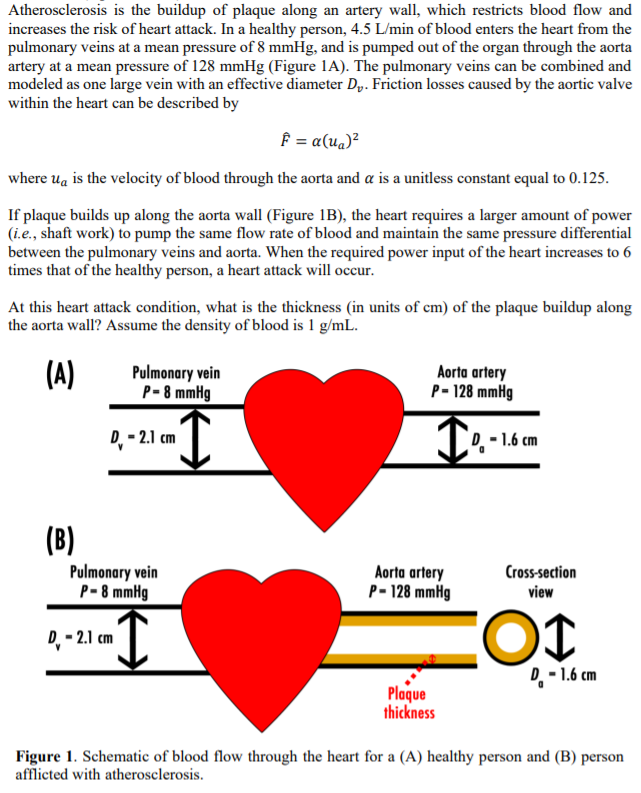
Atherosclerosis is the buildup of plaque along an artery wall, which restricts blood flow and increases the risk of heart attack. In a healthy person, 4.5 L/min of blood enters the heart from the pulmonary veins at a mean pressure of 8 mmHg, and is pumped out of the organ through the aorta artery at a mean pressure of 128 mmHg (Figure 1A). The pulmonary veins can be combined and modeled as one large vein with an effective diameter Dy. Friction losses caused by the aortic valve within the heart can be described by f = a(uz) where ua is the velocity of blood through the aorta and a is a unitless constant equal to 0.125. If plaque builds up along the aorta wall (Figure 1B), the heart requires a larger amount of power (i.e., shaft work) to pump the same flow rate of blood and maintain the same pressure differential between the pulmonary veins and aorta. When the required power input of the heart increases to 6 times that of the healthy person, a heart attack will occur. At this heart attack condition, what is the thickness (in units of cm) of the plaque buildup along the aorta wall? Assume the density of blood is 1 g/mL. (A) Pulmonary vein P- 8 mmHg Aorta artery P-128 mmHg D - 2.1 cm - I 2-16 1.6 cm (B) Pulmonary vein P- 8 mmHg Aorta artery P-128 mmHg Cross-section view D - 2.1 cm - I D. - 1.6 cm Plaque thickness Figure 1. Schematic of blood flow through the heart for a (A) healthy person and (B) person afflicted with atherosclerosis. Atherosclerosis is the buildup of plaque along an artery wall, which restricts blood flow and increases the risk of heart attack. In a healthy person, 4.5 L/min of blood enters the heart from the pulmonary veins at a mean pressure of 8 mmHg, and is pumped out of the organ through the aorta artery at a mean pressure of 128 mmHg (Figure 1A). The pulmonary veins can be combined and modeled as one large vein with an effective diameter Dy. Friction losses caused by the aortic valve within the heart can be described by f = a(uz) where ua is the velocity of blood through the aorta and a is a unitless constant equal to 0.125. If plaque builds up along the aorta wall (Figure 1B), the heart requires a larger amount of power (i.e., shaft work) to pump the same flow rate of blood and maintain the same pressure differential between the pulmonary veins and aorta. When the required power input of the heart increases to 6 times that of the healthy person, a heart attack will occur. At this heart attack condition, what is the thickness (in units of cm) of the plaque buildup along the aorta wall? Assume the density of blood is 1 g/mL. (A) Pulmonary vein P- 8 mmHg Aorta artery P-128 mmHg D - 2.1 cm - I 2-16 1.6 cm (B) Pulmonary vein P- 8 mmHg Aorta artery P-128 mmHg Cross-section view D - 2.1 cm - I D. - 1.6 cm Plaque thickness Figure 1. Schematic of blood flow through the heart for a (A) healthy person and (B) person afflicted with atherosclerosis







